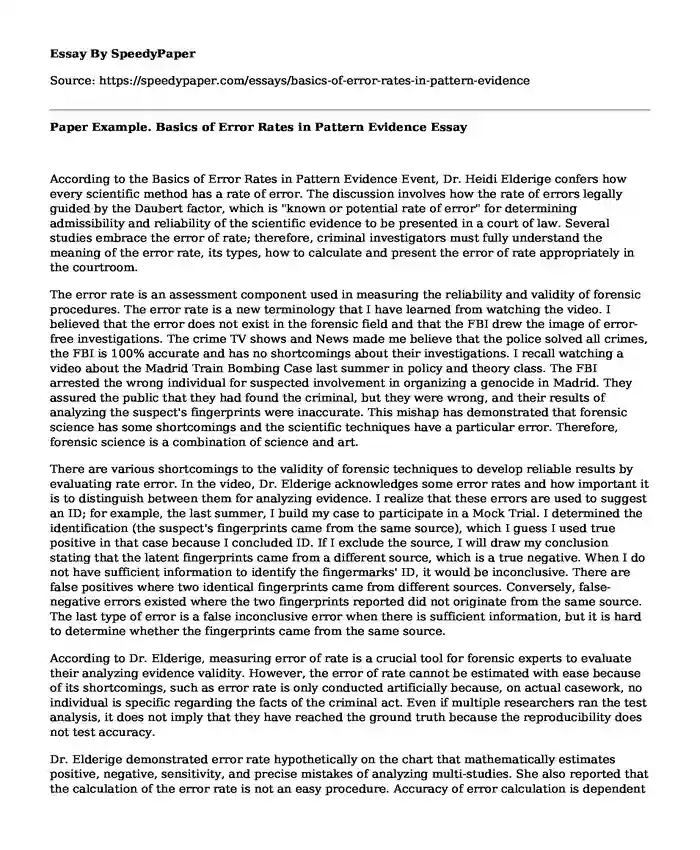
| Essay type: | Persuasive essays |
| Categories: | Knowledge Forensic science Court system Police |
| Pages: | 3 |
| Wordcount: | 697 words |
According to the Basics of Error Rates in Pattern Evidence Event, Dr. Heidi Elderige confers how every scientific method has a rate of error. The discussion involves how the rate of errors legally guided by the Daubert factor, which is "known or potential rate of error" for determining admissibility and reliability of the scientific evidence to be presented in a court of law. Several studies embrace the error of rate; therefore, criminal investigators must fully understand the meaning of the error rate, its types, how to calculate and present the error of rate appropriately in the courtroom.
The error rate is an assessment component used in measuring the reliability and validity of forensic procedures. The error rate is a new terminology that I have learned from watching the video. I believed that the error does not exist in the forensic field and that the FBI drew the image of error-free investigations. The crime TV shows and News made me believe that the police solved all crimes, the FBI is 100% accurate and has no shortcomings about their investigations. I recall watching a video about the Madrid Train Bombing Case last summer in policy and theory class. The FBI arrested the wrong individual for suspected involvement in organizing a genocide in Madrid. They assured the public that they had found the criminal, but they were wrong, and their results of analyzing the suspect's fingerprints were inaccurate. This mishap has demonstrated that forensic science has some shortcomings and the scientific techniques have a particular error. Therefore, forensic science is a combination of science and art.
There are various shortcomings to the validity of forensic techniques to develop reliable results by evaluating rate error. In the video, Dr. Elderige acknowledges some error rates and how important it is to distinguish between them for analyzing evidence. I realize that these errors are used to suggest an ID; for example, the last summer, I build my case to participate in a Mock Trial. I determined the identification (the suspect's fingerprints came from the same source), which I guess I used true positive in that case because I concluded ID. If I exclude the source, I will draw my conclusion stating that the latent fingerprints came from a different source, which is a true negative. When I do not have sufficient information to identify the fingermarks' ID, it would be inconclusive. There are false positives where two identical fingerprints came from different sources. Conversely, false-negative errors existed where the two fingerprints reported did not originate from the same source. The last type of error is a false inconclusive error when there is sufficient information, but it is hard to determine whether the fingerprints came from the same source.
According to Dr. Elderige, measuring error of rate is a crucial tool for forensic experts to evaluate their analyzing evidence validity. However, the error of rate cannot be estimated with ease because of its shortcomings, such as error rate is only conducted artificially because, on actual casework, no individual is specific regarding the facts of the criminal act. Even if multiple researchers ran the test analysis, it does not imply that they have reached the ground truth because the reproducibility does not test accuracy.
Dr. Elderige demonstrated error rate hypothetically on the chart that mathematically estimates positive, negative, sensitivity, and precise mistakes of analyzing multi-studies. She also reported that the calculation of the error rate is not an easy procedure. Accuracy of error calculation is dependent on the type of conducted study. Finally, Dr. Elderige's recommendation is to research and understand how to present the error rate appropriately in the courtroom. It is paramount to articulate to the jury that the error rate was estimated from national studies at particular conditions similar to casework. Also, showing the figures of error rate percentage of a specific field and conducting tests to reduce these errors.
In conclusion, the Basics of Error Rates in Pattern Evidence event helped me learn more about forensic science disciplines. It assists me in learning how to read and calculate the error rate in studies. Most important is to acquire skills on how to talk about error rates in a courtroom as an expert.
Cite this page
Paper Example. Basics of Error Rates in Pattern Evidence. (2023, Dec 03). Retrieved from https://speedypaper.net/essays/basics-of-error-rates-in-pattern-evidence
Request Removal
If you are the original author of this essay and no longer wish to have it published on the SpeedyPaper website, please click below to request its removal:
- Free Essay: The Case against Grammar Correction in L2 Writing Classes Review
- Essay Sample on Horizontal Wells
- Essay Example on Multiple Representations in Teaching
- Essay Sample on Personal Statement for Ph.D. in Chemistry
- Essay Example on Canada Political Scandal
- Understanding Factors in Young Children's Development - Free Essay Sample
- Big Data Benefits, Challenges, and Strategies to Mitigate Risks in Healthcare - Report Example
Popular categories




